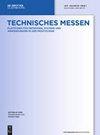用电阻抗谱和支持向量机检测水中微塑料
IF 0.7
4区 工程技术
Q4 INSTRUMENTS & INSTRUMENTATION
引用次数: 2
摘要
水中微塑料的检测需要一系列的过程(样品采集、纯化和制备),直到样品可以在实验室分析。为了缩短这一过程链,我们正在研究基于支持向量机(SVM)的分类器增强的电阻抗谱(EIS)是否可以应用于微塑料检测问题。聚丙烯(PP)和聚烯烃(PO)悬浮液在去离子水中的结果证明了这一点:从测量阻抗中提取的相对介电常数与文献数据一致。随后通过SVM对实测阻抗进行分类,发现“无塑料”(每次填充1 g塑料以下的检测限)、“PP”和“PO”这三类可以独立于背景介质水而安全地区分出来。不检查PO和PP的混合物,即将PO或PP填充到测量池中。支持向量机分类后进行的支持向量机回归产生各自样品的微塑料浓度。对水中不同盐度和有机或生物物质含量的进一步测试证实了良好的结果。我们得出的结论是,EIS与机器学习(MLEIS)相结合似乎是一种有前途的微塑料原位检测方法,当然值得进一步的研究活动。本文章由计算机程序翻译,如有差异,请以英文原文为准。
Detection of microplastics in water using electrical impedance spectroscopy and support vector machines
Abstract The detection of microplastics in water requires a series of processes (sample collection, purification, and preparation) until a sample can be analyzed in the laboratory. To shorten this process chain, we are investigating whether electrical impedance spectroscopy (EIS) enhanced by a classifier based on support vector machine (SVM) can be applied to the problem of microplastics detection. Results with suspensions of polypropylene (PP) and polyolefin (PO) in deionized water proved promising: The relative permittivities extracted from the measured impedances agree with literature data. The subsequent classification of measured impedances by SVM shows that the three classes “no plastic” (below the detection limit of 1 g plastic per filling), “PP” and “PO” can be distinguished securely independent of the background medium water. Mixtures of PO and PP were not examined, i.e. either PO or PP was filled into the measuring cell. An SVM regression performed after the SVM classification yields the microplastic concentration of the respective sample. Further tests with varying salinity and content of organic or biological material in the water confirmed the good results. We conclude that EIS in combination with machine learning (MLEIS) seems to be a promising approach for in situ detection of microplastics and certainly warrants further research activities.
求助全文
通过发布文献求助,成功后即可免费获取论文全文。
去求助
来源期刊

Tm-Technisches Messen
工程技术-仪器仪表
CiteScore
1.70
自引率
20.00%
发文量
105
审稿时长
6-12 weeks
期刊介绍:
The journal promotes dialogue between the developers of application-oriented sensors, measurement systems, and measurement methods and the manufacturers and measurement technologists who use them.
Topics
The manufacture and characteristics of new sensors for measurement technology in the industrial sector
New measurement methods
Hardware and software based processing and analysis of measurement signals to obtain measurement values
The outcomes of employing new measurement systems and methods.
 求助内容:
求助内容: 应助结果提醒方式:
应助结果提醒方式:


